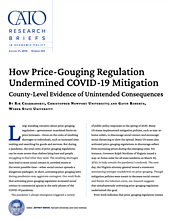Long-standing concerns about price-gouging regulation—government-mandated limits on price increases—focus on the costs of resulting shortages to individuals, such as increased time waiting and searching for goods and services. But during a pandemic, the total costs of price-gouging regulations can be more severe than shelves lying bare and people struggling to find what they need. The resulting shortages may lead to more social contact in crowded stores at the worst possible time—when social contact spreads a dangerous pathogen. In short, activating price-gouging laws during pandemics may aggravate contagion. Our work finds that activating price-gouging regulation increased social contact in commercial spaces in the early phases of the COVID-19 pandemic.
The pandemic’s abrupt emergence triggered a variety of public policy responses in the spring of 2020. Many US states implemented mitigation policies, such as stay-at-home orders, to discourage social contact and encourage social distancing to slow the spread. Many US states also activated price-gouging regulations to discourage sellers from increasing prices during the emerging crisis. For instance, Governor Ralph Northam of Virginia issued a stay-at-home order for all state residents on March 30, 2020, to help contain the pandemic’s outbreak. The next day, the Virginia attorney general issued a statement announcing stronger crackdowns on price-gouging. Though mitigation policies were meant to decrease social contact and flatten the infection curve, our research suggests that simultaneously activating price-gouging regulation undermined this goal.
Prior work indicates that price-gouging regulation creates shortages and that these shortages increase consumer searches. Shortages force consumers to visit more stores and come in contact with more people as they struggle to find what they need. Moreover, recent research motivated by toilet paper stockpiling during the early days of the pandemic shows that there is a feedback loop between shortages induced by fixed prices and stockpiling behavior, which increases consumer searches even further. Our work extends this research by proposing the existence of a new cost associated with price-gouging regulation and testing for it.
Our research uses county-level daily data on social contact and mobility derived from smartphone location data and compares these measures in the states that adopted price-gouging regulations with these measures in the eight states that did not. Thirty-four states had preexisting price-gouging laws, and eight states introduced new price-gouging laws as part of the emergency response to the emerging pandemic.
The results are consistent with price-gouging regulations increasing social contact. Moreover, the results demonstrate that increases in social contact induced by price regulation more than offset the decreases induced by stay-at-home orders. Our research uncovers a strong association between the activation of price-gouging laws and more visits to (and interpersonal contacts in) commercial spaces, even after accounting for differences between counties and the passage of time.
Our results contribute to existing research in two important ways. First, our work identifies a severe yet unnoticed cost associated with activating price-gouging regulation during pandemics. This cost is relevant to the vigorous policy debate surrounding the impacts of price-gouging laws. The discovery of this cost of price-gouging regulation during pandemics adds to the emerging but still scarce research on price-gouging specific to the COVID-19 pandemic.
Second, our results offer an explanation for recent unanticipated findings regarding mitigation strategies. Recent studies have found lower-than-anticipated effectiveness of mitigation policies such as stay-at-home orders in curbing the pandemic’s spread. Our results suggest an unnoticed role of price-gouging regulations—increasing social contact and undermining mitigation—behind these surprising findings.
Our results should concern policymakers. Recent studies have found strong connections between lower community-level mobility and lower COVID-19 case growth, or higher incidence of people staying at home and lower COVID-19 case growth. These connections, paired with our findings, indicate price-gouging regulation may well have increased COVID-19 case growth during the critical early stages of the pandemic.
Note
This research brief is based on Rik Chakraborti and Gavin Roberts, “How Price-Gouging Regulation Undermined COVID-19 Mitigation: County-Level Evidence of Unintended Consequences,” Public Choice 196 (2023): 51–83.

This work is licensed under a Creative Commons Attribution-NonCommercial-ShareAlike 4.0 International License.
